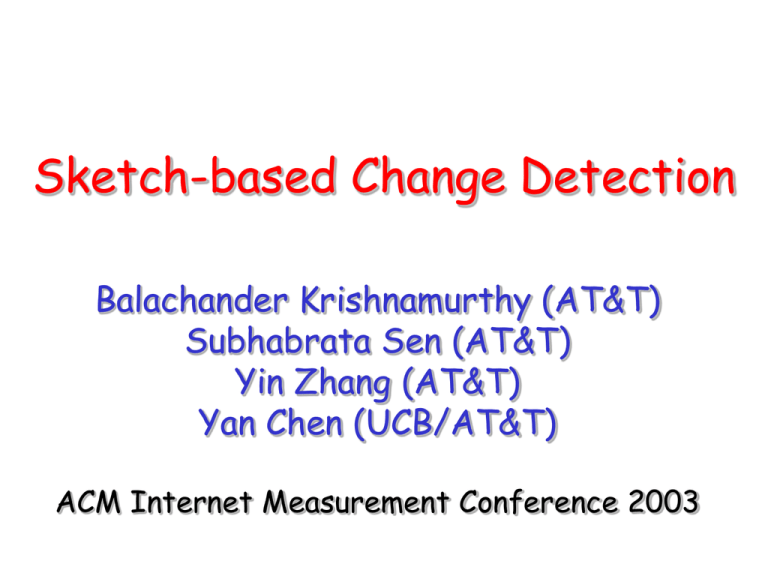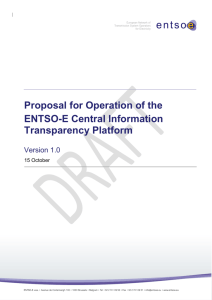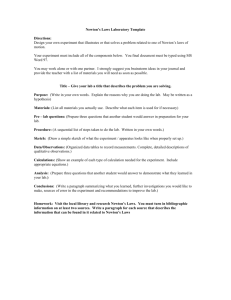Sketch-based Change Detection
advertisement

Sketch-based Change Detection Balachander Krishnamurthy (AT&T) Subhabrata Sen (AT&T) Yin Zhang (AT&T) Yan Chen (UCB/AT&T) ACM Internet Measurement Conference 2003 Network Anomaly Detection • Network anomalies are common – Flash crowds, failures, DoS, worms, … • Want to catch them quickly and accurately • Two basic approaches – Signature-based: looking for known patterns • E.g. backscatter [Moore et al.] uses address uniformity • Easy to evade (e.g., mutating worms) – Statistics-based: looking for abnormal behavior • E.g., heavy hitters, big changes • Prior knowledge not required This talk 2 Change Detection • Lots of prior work – Simple smoothing & forecasting • Exponentially weighted moving average (EWMA) – Box-Jenkins (ARIMA) modeling • Tsay, Chen/Liu (in statistics and economics) – Wavelet-based approach • Barford et al. [IMW01, IMW02] 3 The Challenge • Potentially tens of millions of time series ! – Need to work at very low aggregation level (e.g., IP level) • Changes may be buried inside aggregated traffic – The Moore’s Law on traffic growth … • Per-flow analysis is too slow / expensive – Want to work in near real time • Existing approaches not directly applicable – Estan & Varghese focus on heavy-hitters Need scalable change detection 4 Sketch-based Change Detection (k,u) … • • • • Sketch module Sketches Forecast module(s) Error Sketch Change Alarms detection module Input stream: (key, update) Summarize input stream using sketches Build forecast models on top of sketches Report flows with large forecast errors 5 Outline • Sketch-based change detection – Sketch module – Forecast module – Change detection module • Evaluation • Conclusion & future work 6 Sketch • Probabilistic summary of data streams – Originated in STOC 1996 [AMS96] – Widely used in database research to handle massive data streams Space Accuracy Hash table Per-key state 100% Sketch Compact With probabilistic guarantees (better for larger values) 7 K-ary Sketch • Array of hash tables: Tj[K] (j = 1, …, H) – Similar to count sketch, counting bloom filter, multi-stage filter, … • Update (k, u): Tj [ hj(k)] += u (for all j) 0 1 … h1(k) K-1 1 … hj(k) j … hH(k) H 8 K-ary Sketch (cont’d) • Estimate v(S, k): sum of updates for key k unbiased estimator of v(S,k) with low variance median boost confidence j T j [h j (k )] sum / K 1 1/ K v(S, k) + noise 0 1 compensate for signal loss … h1(k) v(S, k)/K + E(noise) K-1 1 … hj(k) j … H hH(k) 9 K-ary Sketch (cont’d) • Estimate the second moment (F2) F2 (S) k v(S, k) 2 • Sketches are linear – Can combine sketches + = – Can aggregate data from different times, locations, and sources 10 Forecast Model: EWMA • Compute forecast error sketch: Serror = Serror(t-1) Sobserved(t-1) Sforecast(t-1) • Update forecast sketch: Sforecast = Sforecast(t) *a + Sobserved(t-1) *(1a) Sforecast(t-1) 11 Other Forecast Models • Simple smoothing methods – Moving Average (MA) – S-shaped Moving Average (SMA) – Non-Seasonal Holt-Winters (NSHW) • ARIMA models (p,d,q) – ARIMA 0 – ARIMA 1 (p 2, d=0, q 2) (p 2, d=1, q 2) 12 Find Big Changes • Top N – Find N biggest forecast errors – Need to maintain a heap • Thresholding – Find forecast errors above a threshold v(S error , k) Thresh F2 (Serror ) 13 Evaluation Methodology • Accuracy – Metric: similarity to per-flow analysis results – This talk focuses on • TopN (Thresholding is very similar) • Accuracy on real traces (Also has data-independent probabilistic accuracy guarantees) • Efficiency – Metric: time per operation • Dataset description #records Data Netflow Duration #routers Total Range 4 hours 190M 861K – 60M 10 14 Experimental parameters Parameter Values H 1, 5, 9, 25 K 8K, 32K, 64K N 50, 100, 500, 1000 Interval 1 min., 5 min. Model 6 forecast models Router 10 (this talk: Large, Medium) 15 Accuracy H = 5, K = 32768, Router = Large 0.9 0.9 Similarity 1 Similarity 1 0.8 0.8 0.7 0.7 0.6 0.5 0 topN=50 topN=100 topN=500 topN=1000 5 10 15 20 25 30 35 Time (unit = 5 min.) 0.6 0.5 0 topN=50 topN=100 topN=500 topN=1000 30 60 90 120 150 180 Time (unit = 1 min.) Similarity = | TopN_sketch TopN_perflow | / N 16 Accuracy (cont’d) Model = EWMA, Router = Large 1 Average Similarity Average Similarity 1 0.8 0.8 0.6 0.6 0.4 0.2 0 8192 0.4 topN=50, H=5 topN=100, H=5 topN=500, H=5 topN=1000, H=5 32768 K Interval = 5 min. 0.2 65536 0 8192 topN=50, H=5 topN=100, H=5 topN=500, H=5 topN=1000, H=5 32768 K 65536 Interval = 1 min. 17 Accuracy (cont’d) Model = ARIMA 0, Interval = 5 min. 1 Average Similarity Average Similarity 1 0.8 0.8 0.6 0.6 0.4 0.2 0 8192 0.4 topN=50, H=5 topN=100, H=5 topN=500, H=5 topN=1000, H=5 32768 K Router = Large 0.2 65536 0 8192 topN=50, H=5 topN=100, H=5 topN=500, H=5 topN=1000, H=5 32768 K 65536 Router = Medium 18 Accuracy Summary • For small N (50, 100), even small K (8K) gives very high accuracy • For large N (1000), K = 32K gives about 95% accuracy • Router, interval, and forecast model make little difference • H generally has little impact 19 Efficiency Nanoseconds per operation Operation (H=5, K = 64K) Hash computation Update cost Estimate cost 400MHz SGI R12k 900MHz Ultrasparc-II 34 81 269 89 45 146 1 Gbps = 320 nsec per 40-byte packet Can potentially work in near real time. 20 Conclusion • Sketch-based change detection (k,u) … Sketch module Sketches Forecast module(s) Error Sketch Change detection module Alarms • Scalable – Can handle tens of millions of time series • Accurate – Provable probabilistic accuracy guarantees – Even more accurate on real Internet traces • Efficient – Can potentially work in near real time 21 Ongoing and Future Work • Refinements – Avoid boundary effects due to fixed interval – Automatically reconfigure parameters – Combine with sampling • Extensions – Online detection of multi-dimensional hierarchical heavy hitters and changes • Applications – Building block for network anomaly detection 22 Thank you! 23 Heavy Hitter vs. Change Detection • Change detection for heavy hitters – Can potentially use different parameters for different flows – Heavy hitter ≠ big change • Need small threshold to avoid missing changes – Aggregation is difficult • Sketch-based change detection – All flows share the same model parameters – Aggregation is very easy due to linearity 24






